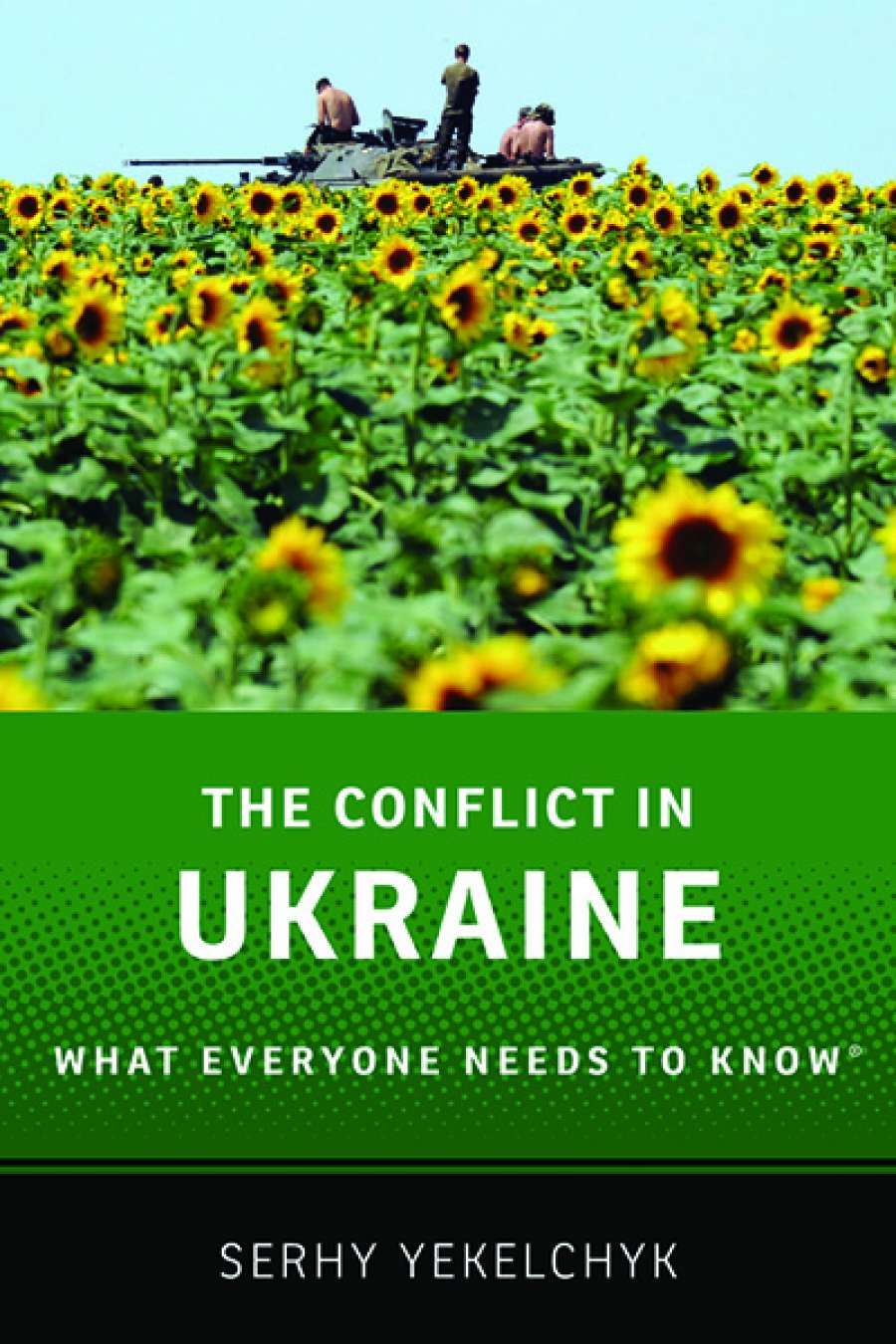
- Free Article: No
- Contents Category: Military History
- Custom Article Title: Mark Edele reviews 'The Conflict in Ukraine: What everyone needs to know' by Serhy Yekelchyk
- Book 1 Title: The Conflict in Ukraine
- Book 1 Subtitle: What Everyone Needs to Know
- Book 1 Biblio: Oxford University Press, $57.95 hb, 205 pp, 9780190237271
This slim book comes as a welcome intervention into this debate. Serhy Yekelchyk, a Canadian-based historian of the Soviet Union and of Ukraine, offers an expert overview that can be read without any prior knowledge of the region and its history. Seven short chapters are organised each with a catalogue of the most commonly asked questions on Ukraine, Russia, and the war. His account dismantles the most widespread misconceptions, often in only a few pages.
Rather than a Ukraine divided into Ukrainians in the west and Russians in the east, Yekelchyk sketches four different regions making up modern Ukraine. In the west, roughly a quarter of the country was acquired by the Soviet Union during World War II. Formerly part of the Austro-Hungarian Empire, these lands were part of Poland, Hungary, Romania, and Czechoslovakia in the interwar years. On the other extreme is Crimea, now annexed by Russia. Overwhelmingly ethnically Russian ever since Stalin deported the Crimean Tatars, this region had been part of the Russian republic within the Soviet Union until transferred to Ukraine by Nikita Khrushchev in order to create more coherent economic regions and to please his power base. Politically, it has been dominated by a 'fusion of Soviet nostalgia with Russian cultural identity', which explains the support many locals gave to the illegal Russian acquisition of the peninsula. More complex is the Donbas, the scene of the current armed conflict and the site of the MH17 disaster. This borderland with Russia is an old industrial region where nostalgia for the Soviet Union runs high, but where Ukrainians, not Russians, form the majority. Third, there is central Ukraine, which had first been part of the Russian Empire then of the Soviet Union. Much more 'Soviet' than the west, it used to vote with the east of the country, but more recently tends westward.
 A sea of flowers at Schiphol Airport for the victims of the Flight MH17 disaster (photograph by By JurgenNL, via Wikimedia Commons)
A sea of flowers at Schiphol Airport for the victims of the Flight MH17 disaster (photograph by By JurgenNL, via Wikimedia Commons)
To add to the complexity of the situation, political identities are not simple. Many identify as Ukrainians, but speak Russian as their first language. 'Ukraine' can stand for an ethnicity, but also for a civic nation – a state of citizens. Russians do not necessarily side with the anti-Ukrainian forces. Hence, the conflict in Ukraine is not between 'Russians' and 'Ukrainians', but between political élites, democratic revolution, the Russian state, far-right groups from both Russia and Ukraine, and adventurers and political entrepreneurs of various stripes. Rather than a struggle for national self-determination, this is a political contest masquerading as ethnic strife: the underlying fight is over opposing political models – democracy or paternalism.
Yekelchyk does not hide his sympathies with the Ukrainian democratic ('Orange') revolution or his disdain for both the pre-2014 Ukrainian political establishment (a 'kleptocracy') and Putin's Russia (an internationally aggressive form of 'authoritarian state capitalism'). Nevertheless, his analysis is no partisan polemic. He points to the absurdity of constructing clear lines of continuity from tenth-century Kievan Rus to modern Ukraine or modern Russia, respectively, and does not paper over dark chapters in Ukraine's national history, such as recurrent violence against Jews. His treatment of the 1932–33 famine, which as 'the Holodomor' has become a touchstone of Ukrainian nationalism, is as nuanced as his exploration of the life and influence of the nationalist activist Stepan Bandera – freedom fighter to some, fascist to others. Closer to the events at hand, Yekelchyk's discussion of the role of radical right and neo-Nazi groups in the Ukrainian revolution of 2013–14 sidesteps apologetics as much as hysterical accounts of the Euromaidan as a 'fascist coup'. Instead, Yekelchyk stresses both the complete failure at the ballot box of these fringe groups and their important role during the violent phase of the protests and later in the Donbas fighting.
 A girl attaches flowers to riot police officers' shields during the Orange Revolution in Kiev (photograph by jf1234, via Wikimedia Commons)
A girl attaches flowers to riot police officers' shields during the Orange Revolution in Kiev (photograph by jf1234, via Wikimedia Commons)
Such even-handedness recommends the author and his book. Wherever one stands in relation to this conflict, the book has to be on the 'essential reading' list. It provides a succinct and informed overview of the history of the region and the genesis of the war. It equips the reader to question established stereotypes and thus elevates the level of discourse to one where reasoned and informed disagreement becomes possible. Highly recommended.


Comments powered by CComment